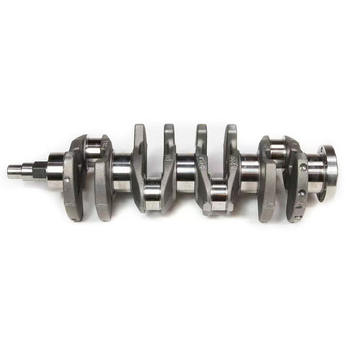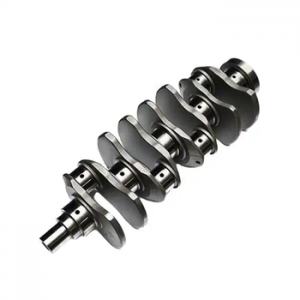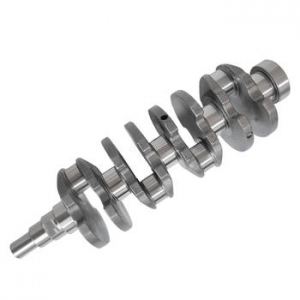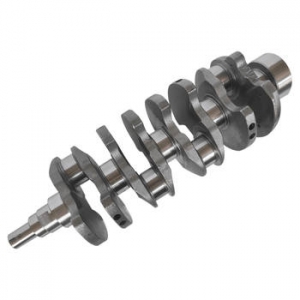Crankshaft Distributor: The Unsung Hero of Precision Engine Timing
When you pop the hood of a car, your eyes are probably drawn to the big, obvious parts: the engine block, the intake manifold, maybe a turbocharger if you're lucky. But tucked away, often out of sight, are the components that truly make the magic happen. One of the most critical yet often misunderstood of these parts is the ignition distributor. And while many are familiar with the traditional camshaft-driven distributor, its more precise and reliable cousin, the crankshaft distributor, represents a major leap forward in engine technology. It's the bridge between old-school mechanical timing and modern computer-controlled ignition.
Frankly speaking, most drivers will never have to think about this component. But for enthusiasts, restorers, and anyone curious about what makes an internal combustion engine tick with Swiss-watch precision, understanding the crankshaft distributor is key. It’s a fascinating piece of engineering that directly impacts performance, efficiency, and reliability. So, let's dive deep into the world of this unsung hero.
What Exactly is a Crankshaft Distributor? A Clearer Path to Ignition
At its core, any distributor's job is to "distribute" high-voltage electricity from the ignition coil to the correct spark plug at the perfect moment. This ignites the air-fuel mixture in the cylinder, pushing the piston down and creating power. For decades, the standard was a distributor driven by the engine's camshaft.
However, this classic setup has an inherent flaw. The camshaft is connected to the crankshaft by a timing belt or chain. Over time, these belts and chains can stretch, and the gears can wear. This introduces a tiny amount of "slop" or inaccuracy into the system. While it might only be a degree or two, that small error can be the difference between a perfectly smooth, powerful engine and one that feels a bit sluggish or inefficient.
Enter the crankshaft distributor. As the name implies, this type of distributor takes its rotational input directly from the nose of the crankshaft. Why is this a game-changer? Because the crankshaft's rotation is the absolute source of truth for an engine's timing. It represents exactly where the pistons are in their cycles, with no intermediate chains or gears to introduce errors. By mounting the distributor here, you get the most accurate possible mechanical signal for ignition timing.
Interestingly enough, these systems often don't look like a traditional distributor with a big cap and rotor. Many are more compact and work in tandem with an electronic ignition module, using a crankshaft position sensor (or a trigger wheel) to tell the module when to fire the coil. This design was a pivotal step towards the fully electronic, distributorless ignition systems (DIS) found in all modern cars.

How a Crankshaft Mounted Distributor Actually Works
Have you ever wondered how your engine knows the exact millisecond to create a spark? It's all about timing, and a crankshaft mounted distributor system refines this process beautifully. While designs can vary, the fundamental principle remains the same: reading the crankshaft's position directly to control spark delivery.
The Key Components
To understand the "how," let's break down the typical parts involved in what many experts refer to as a crankshaft trigger system:
- Trigger Wheel: This is a toothed wheel mounted directly to the crankshaft's harmonic balancer or pulley. The teeth are precisely spaced, but there's often a "missing" tooth or a unique pattern. This missing tooth acts as a reference point, telling the system where the crankshaft is in its 360-degree rotation—specifically, when the #1 piston is at Top Dead Center (TDC).
- Crankshaft Position Sensor (CPS): This sensor, typically a Hall effect or variable reluctance sensor, is mounted on a fixed bracket right next to the trigger wheel. As the toothed wheel spins past the sensor, it generates a series of electrical pulses—a digital signal. The missing tooth creates a unique gap in this signal, providing that crucial reference point.
- Ignition Control Module (or ECU): The signal from the CPS is sent to an ignition control module or, in more advanced setups, the main Engine Control Unit (ECU). This electronic brain is the real star of the show. It takes the raw timing signal from the crank and then calculates the optimal moment to fire the spark.
- The Distributor (or Coil Pack): In some systems, the signal from the module still goes to a distributor body, which then routes the spark via a rotor and cap. However, in many performance applications and later factory systems, the module fires a coil pack directly, which sends spark to the plugs via high-tension leads. This is a step closer to a true distributorless system.
The Step-by-Step Process
So, let's put it all together. When you turn the key:
- The crankshaft begins to spin, turning the trigger wheel with it.
- The teeth on the wheel fly past the crankshaft position sensor, which generates a precise stream of pulses.
- The ignition module receives these pulses. It uses the timing of the pulses to calculate engine RPM and the unique signal from the missing tooth to know the exact position of the crankshaft.
- Based on its internal programming (or "map"), which considers factors like engine speed and load, the module determines the ideal ignition advance. For example, at higher RPMs, the spark needs to happen a little earlier (advanced) to ensure the flame front has time to spread.
- At the calculated moment, the module sends a signal to the ignition coil to fire, creating a high-voltage spark that is delivered to the correct cylinder.
This entire process happens hundreds or even thousands of times per minute with incredible accuracy. It's a far more stable and reliable method than relying on a camshaft-driven system, which can suffer from "cam walk" or timing chain stretch, throwing the spark timing off. In my experience, converting to a crank trigger system is one of the most effective ways to stabilize ignition timing on a high-performance or older engine.
The Undeniable Advantages of a Crankshaft Distributor System
Upgrading or choosing a vehicle with a crankshaft distributor isn't just about having a different piece of hardware; it's about unlocking tangible benefits in performance, efficiency, and reliability. To be honest, the difference can be night and day, especially on a tuned or high-mileage engine.
Unmatched Timing Accuracy
This is the number one benefit. As we've discussed, traditional distributors are driven off the camshaft, which is one step removed from the crankshaft. The timing chain or belt that connects them is a point of failure and inaccuracy. It can stretch, jump a tooth, or introduce harmonic vibrations that cause "spark scatter"—inconsistent timing from one cylinder firing to the next.
A crankshaft distributor or trigger system eliminates this entire chain of potential errors. The timing signal is taken directly from the source. This results in rock-solid, stable timing at all RPMs. Many experts agree that stable timing is the foundation of a healthy, powerful engine. Without it, you're just guessing.
Boosted Engine Performance and Fuel Efficiency
What does stable timing get you? Better performance. When the spark plug fires at the optimal moment every single time, you get a more complete and efficient combustion of the air-fuel mixture. This translates directly to:
- More Horsepower and Torque: A complete burn pushes the piston down with maximum force.
- Sharper Throttle Response: The engine responds more crisply to your inputs.
- Smoother Idle and Revving: Eliminating spark scatter results in a noticeably smoother-running engine.
- Improved Fuel Economy: You're extracting more energy from every drop of fuel, which means less waste and better MPG.
Superior Reliability and Less Maintenance
Fewer moving parts almost always means greater reliability. A traditional distributor has gears, bushings, and a mechanical advance mechanism (weights and springs) that can all wear out over time. A crankshaft trigger system, by contrast, is mostly solid-state. The sensor and trigger wheel have no physical contact and don't wear out in the same way. This means less maintenance and fewer points of failure, which is a huge plus for both daily drivers and weekend race cars.
For those with classic cars, installing a crankshaft distributor conversion kit is a popular upgrade. It provides the reliability of modern electronics while often allowing you to keep a relatively stock appearance.

Diagnosing Common Issues: Troubleshooting Your System
While crankshaft-triggered ignition systems are incredibly reliable, they aren't invincible. When problems do arise, they can be frustrating because they often lead to a no-start condition or severe running issues. Knowing where to look can save you a lot of time and money.
The Usual Suspects: Sensor and Wiring
It's worth noting that the most common point of failure is almost always the crankshaft position sensor (CPS) itself or its wiring. Over years of heat cycles and vibrations, these components can degrade.
Symptoms of a Failing CPS:
- Engine Cranks but Won't Start: This is the classic symptom. The ECU gets no signal from the CPS, so it doesn't know the engine is turning and, therefore, won't fire the spark plugs or fuel injectors.
- Intermittent Stalling: The engine might run fine and then suddenly die, sometimes restarting after it cools down. This often points to an electrical component failing when hot.
- Rough Idle or Misfires: If the sensor's signal is weak or erratic, the ECU can get confused, leading to inconsistent timing and misfires.
- Check Engine Light: A failing CPS will almost always trigger a diagnostic trouble code (DTC), illuminating the check engine light.
Troubleshooting Steps
If you suspect an issue, here’s a basic diagnostic path:
- Check for Codes: The first step is always to scan the vehicle's computer for trouble codes. A code related to "Crankshaft Position Sensor Circuit" is your smoking gun.
- Visual Inspection: Look at the sensor and its wiring. Is the connector secure? Are there any frayed or melted wires? Is the sensor covered in grime or metal shavings that could interfere with its reading?
- Check the Air Gap: The distance between the sensor and the trigger wheel is critical. This is called the "air gap." If it's too large or too small, the signal can be weak or non-existent. Consult a service manual for the correct specification and use a feeler gauge to check it.
- Test the Sensor: You can test the sensor itself with a multimeter. For a variable reluctance sensor, you can check its resistance. For a Hall effect sensor, you'd check for a voltage signal while the engine is being cranked. Again, a service manual is your best friend here.
In my experience, nine times out of ten, the problem is a bad sensor or a damaged connector. They are relatively inexpensive parts and often easy to replace, making this a very manageable DIY repair for many home mechanics.
Is a Crankshaft Distributor Conversion Right for You?
For owners of classic cars, hot rods, or older project cars still running a traditional distributor, the question often arises: is it worth upgrading? A crankshaft distributor conversion kit can seem like a complex and expensive modification, but the benefits can be transformative.
Who Should Consider the Upgrade?
This conversion isn't for everyone, but it's a fantastic option for:
- Performance Enthusiasts: If you've modified your engine with a bigger cam, higher compression, or forced induction (turbo/supercharger), precise timing is no longer a luxury—it's a necessity. A crank trigger system will allow you to tune your ignition map perfectly to extract maximum power safely.
- Classic Car Owners Seeking Reliability: Do you love the look of your classic but hate fiddling with points or dealing with a worn-out distributor? A conversion kit gives you modern, fire-and-forget reliability. You get a car that starts easier, idles smoother, and is more enjoyable to drive.
- Racers: In any form of motorsport, from drag racing to road racing, a stable ignition signal at high RPM is absolutely critical. A crank trigger is standard equipment on virtually all serious race engines for this reason.
What's Involved in the Conversion?
A typical conversion kit will include the trigger wheel, the crank sensor, a mounting bracket, and an ignition control module. The installation involves mounting the wheel to your crankshaft pulley, fabricating a sturdy bracket for the sensor, and wiring everything to the ignition module and coil(s). While it's a job that a skilled DIYer can tackle, it requires precision. The sensor bracket must be rigid, and the air gap must be set perfectly.
Have you ever been frustrated by the limitations of your old ignition system? If so, exploring a conversion might be the most rewarding upgrade you ever make. It addresses the very foundation of how your engine runs, providing a stable platform for all other performance modifications.
Ultimately, the crankshaft distributor and its modern crank-trigger evolution represent a fundamental shift in how we control engine timing. It’s a move away from mechanical approximation and towards electronic precision. Whether it's a factory-installed system or a performance upgrade, its role in delivering a perfectly timed spark is what allows our engines to run with the power, smoothness, and efficiency we demand.
For more detailed information, please visit our official website:Crankshaft distributor
About the author: Marcus 'Sparky' Chen has been a performance engine builder and ASE-certified master technician for over 25 years. He specializes in ignition systems, from vintage points-based distributors to modern coil-on-plug setups. When he's not in the garage, he's writing for automotive publications, sharing his passion for making engines run their absolute best.
 Crankshaft Distributor: The Un
Crankshaft Distributor: The Un
 The Ultimate Guide to Sourcing
The Ultimate Guide to Sourcing
 Power Your Business: A Deep Di
Power Your Business: A Deep Di
 Choosing the Right Crankshaft
Choosing the Right Crankshaft
